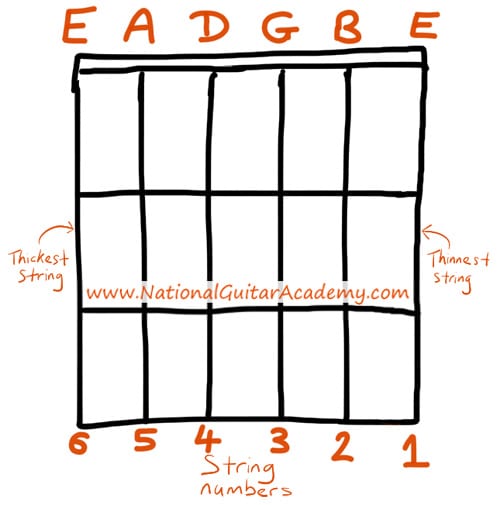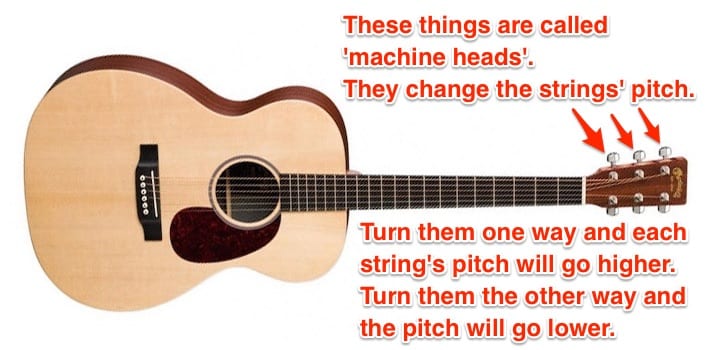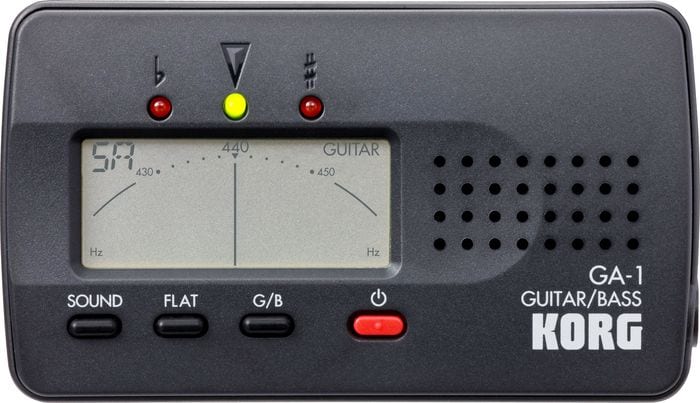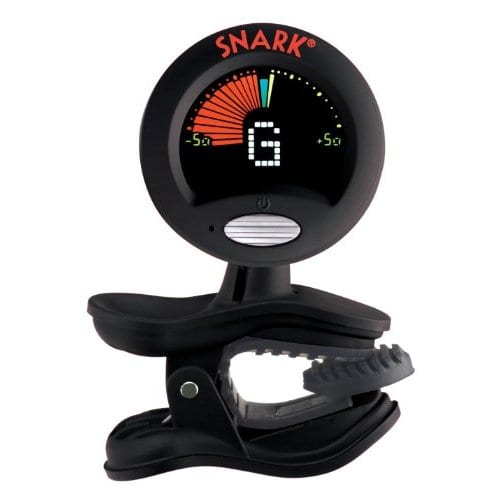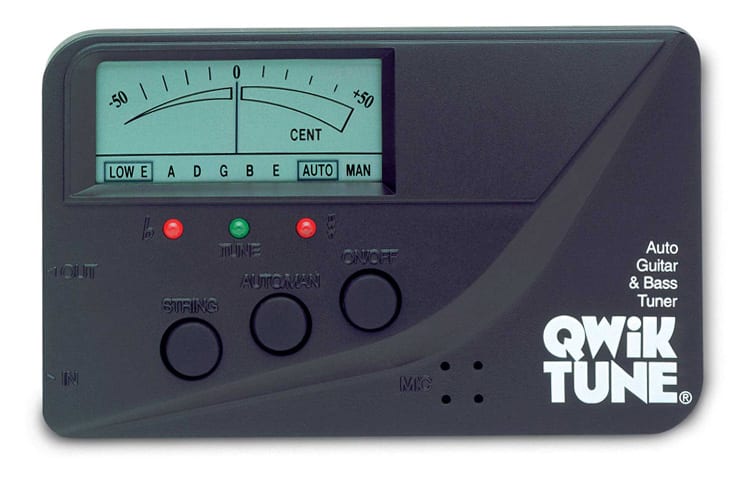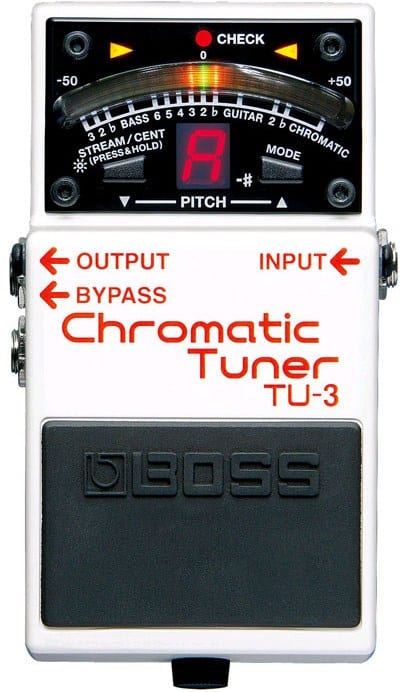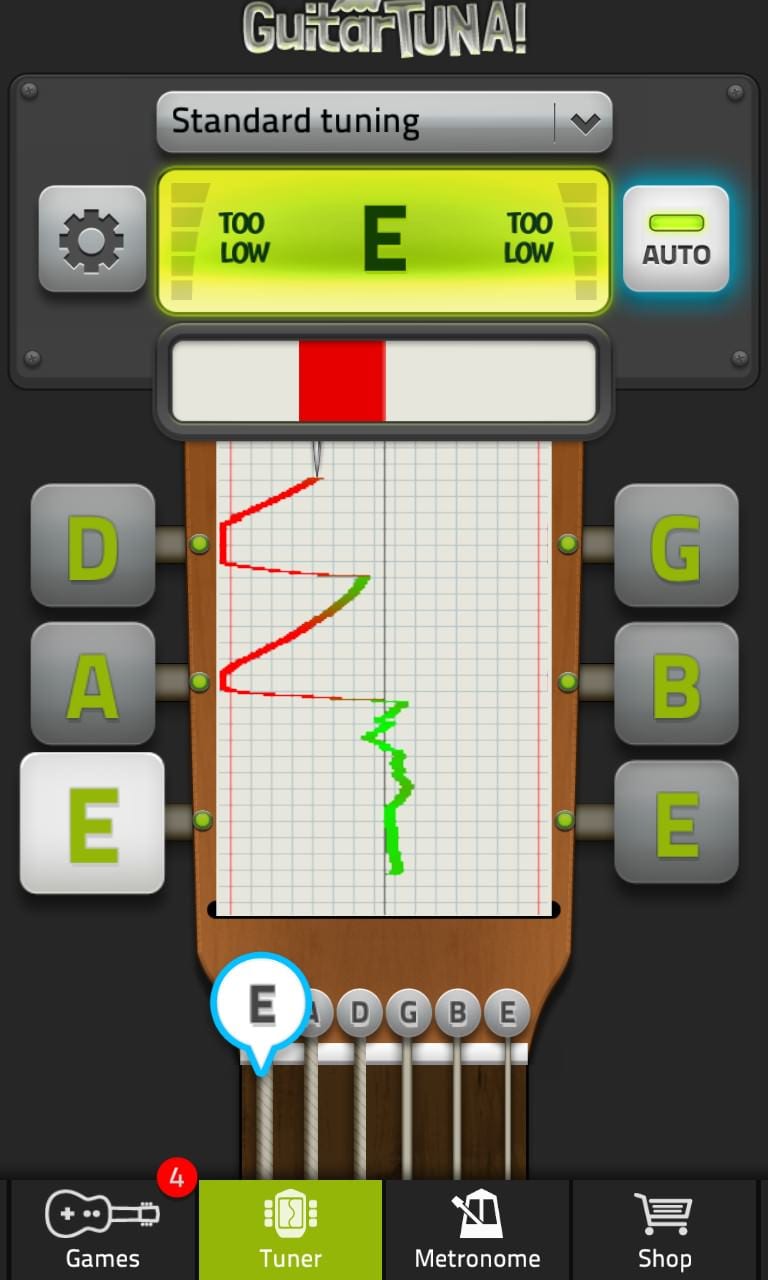Need to know how to tune a guitar? We’ve got you covered. Let’s dive straight into this essential beginner guide.
You’re at the start of a wonderful journey and we’re so pleased you’re here. 🙂
It’s vital that you learn how to tune a guitar; it’s essential knowledge for a beginner guitarist.
FACT: You can be the best guitarist globally, but if your guitar is out of tune, you will sound bad.
In this free guitar lesson you will learn:
- The notes of a guitar in standard tuning.
- How to tune a guitar using an electronic guitar tuner.
- How to tune a guitar using a smartphone app.
- How to tune a guitar using other instruments.
- How to tune a guitar using its own strings (and your ears!)
- 6 tips to keep your guitar in tune & sounding great
Sound good? Let’s do it.

.
How to tune a guitar in standard tuning
There are several different guitar tuning profiles, but the most popular one by far is called ‘standard tuning’ pattern.
In standard guitar tuning, the notes of the guitar, from thickest to thinnest, are:
E, A, D, G, B, E
(If you don't understand the above image please read our article "How To Read Guitar Chordboxes In 60 Seconds". It will make everything clear!)
How to remember the order of the guitar strings
Here are two useful mnemonics to help you remember the order of the six open strings “E, A, D, G, B, E”.
- Elephants And Donkeys Grow Big Ears
- Eddie Ate Dynamite Good Bye Eddie
Pick whichever one you like best, or make up your own. (The sillier the better.)
Now we know the notes we’re aiming for we can tune the guitar
You’ve already learned the first half of how to tune a guitar, well done!
Now we need to look at how to tune a guitar to E, A, D, G, B, E.
How to tune a guitar to E, A, D, G, B, E
Look at your guitar’s headstock (the thin end of the guitar).
You will see small ‘keys’ that you can turn. We call these ‘machine heads’.
Each guitar string is attached to a machine head of its own. When we turn a machine head, we change the pitch that the guitar string is tuned to.
How do we know what note the guitar string is tuned to when turning the machine heads?
Easy. We use a tuner to tell us! 🙂
If you’re wondering how to tune a guitar with what you have at hand there’s 4 methods (we’ll cover each one in turn):
- How to tune a guitar using an electronic guitar tuner.
- How to tune a guitar using a smartphone app.
- How to tune a guitar using other instruments.
- How to tune a guitar using its own strings (and your ears!)
Learn 12 EASY beginner chords with our popular guide


Where should we send it?
✅ Stop struggling. Start making music.
✅ Learn beginner-friendly versions of every chord.
This is our most popular guide and it will improve your chord ability quickly! 😎
Get your own personalised guitar-learning plan 🎸
Get a custom guitar-learning plan here: Click here for GuitarMetrics™
World-Class Guitar Courses 🌎
Learn from the world's best guitar educators: Click here for our guitar courses
Guitar tuning with an electronic guitar tuner
When people ask me how to tune a guitar I always say the same thing: All things considered, electronic guitar tuners are the best option.
They are fast and accurate. (When you have a decent electronic guitar tuner you simply won’t need to worry about how to tune a guitar again.)
The interface of ALL tuners is broadly the same.
You pluck a note and the tuner shows you the note you played.
The tuner shows you this in three ways:
- It will tell you the string it thinks you’re trying to tune.
- It will show you with an oscillating ‘needle’ how far away from the note you are.
- It will show you with a light whether the note is too low or too high.
You need to get the needle in the middle.
In the picture above the ‘needle’ is perfectly in the middle. (Can you see the thin, black vertical line?)
Because the needle is perfectly in the middle, the green light above it is lit. This note is perfectly in tune!
We can see it’s tuning the A string (the fith string) because in the top left corner it says “5A”.
- The green light would not be lit if the needle was over to the left. The red light to the left of it would be lit, and this would tell us the note was too ‘flat’ (too low).
- If the needle was over to the right, again the green light would not be lit. The red light to the right would be lit and this would tell us the note was too ‘sharp’ (too high).
Got that? Ok, let’s tune up!
1 – Turn the tuner on.
2 – If necessary, tell the tuner the string you want to tune. (Most tuners default to ‘auto-detect’ the strings, but some tuners need to be manually told what string you want to tune.)
Important! If your tuner is manual, then make sure your tuner is ‘listening’ for the correct string that you want to tune. If the tuner is set to ‘listen’ to a different string to the one you are tuning you may overtune the string and it will snap!
3 – Pluck a string.
4 – Look at the tuner. Is the needle in the middle? If not turn the machine head one way or the other.
5 – Pluck again. Which way did the needle go? If it went towards the middle, keep going! If it went away from the middle, turn the machine head in the opposite direction.
6 – Repeat the cycle of A) pluck string B) look at tuner and C) turn machine head until the needle is in the middle.
.
While tuning, pluck the string a LOT.
Most beginners are quite timid and pluck once and then wait for ages while the tuner ‘listens’ for a note that’s stopped ringing.
Don’t do this. You should pluck, pluck, pluck away!
The more your guitar is ringing out a note the easier it is for the tuner to hear, so pluck lots. (About once a second is ideal.)
If you want to learn more about the notes of the guitar fretboard read our article:
Guitar Notes Explained: A Guide For Beginners
There are 3 different types of electronic tuner.
- Vibration-based
- Microphone-based
- Plug-in / pedal-based
Ideally, we want you to know how to tune your guitar with all three.
It’s pretty easy: ‘get the needle in the middle’ remains our aim.
Vibration-based electronic tuners
Vibration-based tuners clip on to your guitar’s headstock. I love these!
They are brilliant if you’re in a noisy place as they detect the note’s correct pitch through vibration, so if there’s lots of noise around, it doesn’t affect the tuner (because it isn’t reliant on a microphone).
Once in position and switched ON, they will automatically show you what note your strings is tuned to when you pluck it. (You don’t need to worry about ‘manual’ or ‘auto-detection.)
They are very accurate and have colour LCD displays that are easy to read, even in bright sunlight. (The ‘needle’ is indicated by different colours.)
This is my favourite vibration-based tuner – The Snark.
Microphone-based electronic tuners
Microphone tuners are great and they don’t add any clutter to your guitar headstock like the clip-on vibration-based tuners do.
The only downside is that the microphone must be able to hear the guitar clearly. If there’s other music in the room (or sound from the TV, or whatever) that will throw the tuner off course.
You can use these for all acoustic guitars and if it has a jack input you can use it for electric guitars too.
As with the clip-on vibration-based tuners these sometimes automatically detect strings, but depending on your model you may have to preselect the note manually.
If you want a recommendation, you can’t go wrong with a trusty Korg GA1 or GA2.
Plug-in and pedal tuners
Plug-in tuners are VERY accurate and connect directly to your electric, bass or electro-acoustic guitar via a jack lead.
They are expensive, but extremely durable and awesome.
Pedals operate like any tuner (the lights represent the ‘needle’), but of course you have to stomp the pedal to activate or deactivate them.
Guitar Tuning with a Smartphone App
For most modern guitar learners, smartphone apps are an excellent cheap starting point for most modern guitar learners when learning how to tune a guitar properly.
There are hundreds of free and paid smartphone apps that are decent. They operate exactly the same as the microphone-based electronic tuners that we covered above.
‘Guitar Tuna’ was good, but it’s getting bloated now. ‘OmniTuner’ is good too.
Search around, the app landscape changes fast and there’s always a new top dog.
How to tune a guitar using other instruments.
If you already play a musical instrument, it’s possible to tune your guitar to it (especially if it has a fixed tuning such as an electronic keyboard).
To learn how to tune a guitar in this way you will need to find E2 A2 D3 G3 B3 E4 on your instrument. (On a keyboard or piano, E2 is two octaves below middle C4.)
You or a friend may need to play each note on your instrument, holding it down as a ‘drone’ so that as you tune your guitar you can listen carefully for the moment the notes start to resonate and sound the same.
(Once you have your low E string, you can tune the others using the below method.)
“Open strings” are strings that are not being pressed (fretted) onto the guitar neck. When you pluck a string without pressing down on any frets, we say you are playing an ‘open string’.
Spock likes guitar.
How to tune a guitar using its own strings (and your ears)
Here is a good 6-step alternative tuning method for ’emergencies’, like if your electronic tuner isn’t to hand and your smartphone’s battery is flat. It’s the ‘anytime, anywhere’ alternate tuning method of how to tune a guitar.
Step 1 – Tune the Sixth string
Tune the thickest open string as accurately as you can to a low E string. It doesn’t have to be perfect. Just ‘guesstimate’ what the thickest string usually sounds like.
(All the other strings will be tuned relative to this, so it doesn’t really matter if it’s a little sharp or flat.)
Step 2 – Tune the fifth string
Place your first finger on the fifth fret of the thickest string. This will give you an ‘A’ note that will sound exactly like how you want the open fifth string to sound.
You can now tune the fifth string to match the note you are holding on the sixth strings.
Keeping your finger on the fifth fret, gently pick both the sixth string and the open fifth string, in turn, gradually turning the fifth strings machine head until the two notes are in harmony.
You need to listen carefully here. The two notes will ‘resonate’ when they match.
Step 3 – Tune the fourth string
We’re going to do the same thing again here, except a string higher.
Place your first finger on the fifth fret of the fifth string. This is a D note.
Keeping your finger on the fifth fret, pluck the fifth string and then the open fourth string one after the other, simultaneously turning the fourth strings machine head until the note of the fourth open string chimes like the note of the fifth fret of the fifth string.
Step 4 – Tune the Third String
Same again. Place your first finger on the fifth fret of the fourth string. This gives a G note.
Keeping your finger on the fifth fret, pluck the fourth string and open the third string alternately, turning the third string’s machine head until the third string is in harmony with the fifth fret method of the fourth string.
Step 5 – Tune the 2nd string
It’s different here. Place your first finger on the fourth fret of the third string, G string. This gives a B note.
Keeping your finger on the fourth fret, pluck the third string and open the second string alternately, turning the second strings machine head until the second string rings brightly with the fourth fret of the third string.
Step 6 – Tune the First String
Place your first finger on the fifth fret on the second string, B string. This is an E note.
Tune the thinnest and last string to that, again by turning the first string’s machine head until the tone of the first string dings with the fifth fret of the second string.
- So you can see we tuned each string to the prior string. To remember this pattern, think “5 5 5 4 5”.
- Don’t forget the second string is the only one that uses the fourth fret to tune from. All the others use the fifth fret method.
6 Top Guitar Tuning Tips
Guitars are more sensitive than most people realise, so bear these things in mind.
1) Tune up EVERY time you play.
This is non-negotiable. As a beginner, your ears won’t be able to tell if your guitar has gone slightly out of tune.
Guitars drift out of tune every day and there is nothing more demotivating for a guitar learner than sounding bad when playing. (I often speak with guitar learners who are feeling down because they think they’re not playing ‘well’, but their guitar is out of tune!)
This isn’t an optional thing. As musicians, we should tune our instruments as part of our routine EVERY time we play.
2) Keep your guitar out of hot places
Your guitar is like any other piece of wood. Temperature affects it. Keep it out of the sun, out of your car on a hot day etc.
Don’t ever rest it against a radiator or any other heat source.
3) Keep your guitar out of cold places
It doesn’t have to be Arctic, even a gentle draft from under a door will nudge your guitar out of tune.
Don’t leave it in your car overnight!
4) Loosen the strings before storage or transport
Loosening your guitar’s strings slightly beforehand allows your guitar to relax and cope with changes in humidity and temperature.
Store your guitar somewhere dry and cool. Away from radiators, air conditioners and any damp conditions.
5) Avoid impacts, big and small
Any kind of bump will knock your guitar out of tune. Of course, if it falls over it will go out of tune, but even little bumps (like a door opening against it) will knock it out.
Also, remember that general play causes your guitar to go out of tune from the constant pressing of your fingers on and off the strings. It happens. It’s normal.
(String-bending solos will always cause a re-tune, too.)
6) Replace your guitar strings regularly.
Dirty, corroded and over-stretched strings become brittle and harder to tune. They also sound terrible!
The right string gauge can also have a huge impact on your ability to tune your guitar properly, so click here to learn about what the correct guitar string gauge is for you.
Change your strings every 6-8 weeks.
What Type of Guitarist Are You?
Take our 60-second quiz & get your results: Take The Quiz
Join the world's best online guitar school 🌎
- Get your own personalised guitar learning plan (customised just for YOU).
- World-class online guitar courses. Learn at your own pace.
- Community Campus & Learning Forum - A friendly community! Connect with our team & students. 😊
- Beginner Song library with chordsheets, tabs and tips. (Songs suitable for all levels!)
- Regular live streams, seminars and Q&A sessions - Learn from world-class guitar educators. Get all your questions answered!
Click here to learn more about National Guitar Academy membership 
Cool Guitar T-shirts 😎
Look cooler! Check out our merch: Click here to see our merch store
Want free guitar tips and video lessons delivered to your inbox?
Join over 100,000 guitar-learners and subscribe to our guitar-tips-by-email service. (It's free.)
We'll send you a series of lessons that will move you to the next level of your guitar journey.
Learn how everything fits together quickly, easily and effectively. We share ninja tips (for instant fun!) but also timeless fundamentals that will deepen your understanding.


Get our best guitar tips & videos
Popular Lessons
How To Learn Guitar: An 11-Step Programme For Beginners
How To Choose The Perfect Beginner Guitar
More Cool Guitar Stuff
Learn about National Guitar Academy: About Us
Join us on Facebook for daily guitar tips.
Listen to our Learn Guitar Podcast for rapid guitar progress.
Check out our free chord lessons.
Where should we send it?


